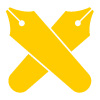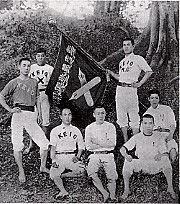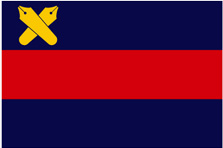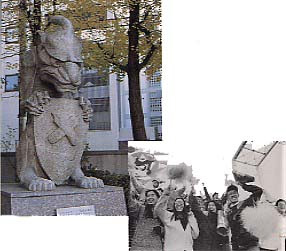Symbols of Keio
Many schools have symbols that express its spirit and tradition. In some cases, these symbols are not only popular among students, faculty and alumni, but are widely recognized in the society as the identity and pride of the school.
In this volume of Keio Views, we will look into the origin and meaning of the most specific symbols of Keio, the "Pen Mark", "Sanshokuki", and the "Unicorn".
Pen Mark
The "Pen Mark" is known as the symbol of Keio University. As for the origin of this mark, there seem to be two stories. The first story is based on reminiscent talk of the people who claim to have created the Pen Mark. Around 1885, a group of students tailored clothes and hats to wear as school uniforms. However, at that time, western clothes were still unusual in Japan, and although the students proudly marched around in their new uniforms, they were sometimes mistaken as foreign students. They felt an urgent need to wear a mark on their hats, and came up with the Pen Mark, inspired from a phrase "the pen is mightier than the sword" from one of their textbooks, because it seemed most suitable for a school emblem. Another story is that Keio students created the mark based on the idea of Yukichi Fukuzawa. Today, there is no way of finding out which is true, but in any case, it seems quite certain that the mark itself was created by a Keio student. A while after the mark was created, the administrative office officially recognized it, and in 1900, it notified Keio University students to wear "a hat with the emblem of the school". The history of the Pen Mark is a good example of the liberalism of Keio.
Today, the phrase "the pen is mightier than the sword" also stands as the motto of Keio, and the stained glass in the old School Library that expresses this phrase is also one of Keio's symbolic features.


Sanshokuki (Blue-Red-Blue Flag)
The school flag of Keio is called the “Sanshokuki” (meaning three-colored flag), but unlike the national flag of France, it is actually two colors in three stripes of blue, red and blue. The meaning of these colors are not clear.
The exact date of establishment is not clearly known, however, in newspaper "Jiji Shimpo" dated 28 November, 1894, there is an article about Keio University students joining a parade for the first time to celebrate the fall of Ryojun in the Sino-Japanese War, carrying tin can lanterns with the school flag flaunting beside them. In "Fuzoku Gaho" volume 82, published in December of the same year, the same news is shown with a picture of the three striped flag with the Pen Mark on its left shoulder, although the colors cannot be distinguished.
The Sanshokuki seems to have appeared around 1895, originally using light blue and red, and around 1898 when Eikichi Kamata became President of Keio University, it seems to have been officially authorized as the school flag. However, the size, shape and colors were not standardized, therefore on 14 February 1964, size and color of the flag and placement of the Pen Mark on the flag was officially standardized.

Both the Pen Mark and Sanshokuki were registered in 1992 as trademarks of Keio University, and are now under the law's protection. Furthermore, in 2005, in preparation for Keio University's 150th anniversary, the Visual Identity Guideline was developed for the Pen Mark, Sanshokuki, etc. The marks have become easier to use as symbols of Keio University.
The Unicorn
Unicorn, meaning "single horn", is an imaginary animal that appears in the Greek myths. On the occasion of renovating the Grand Hall of Mita Campus that was damaged in the Great Kanto Earthquake in 1923, a pair of statues shaped of a unicorn was placed in the third floor balcony for some reason. Although slightly grotesque, the unicorn pair looked charming in a way, and became popular among teachers and students.
The Grand Hall was damaged again during World War II and was torn down. Today, there is nothing left of the Grand Hall. However, in 1962, a unicorn-shaped decoration appeared in the Sokei-sen (Keio-Waseda Baseball Game) in place of Mickey Mouse that was used previously, and helped boost the mood. Since Keio won the Sokei-sen and won the league title, the unicorn became a mascot for Keio students. One of the pair of unicorns, which had been stored, was repaired in 1975 thanks to a donation by graduates of Keio Chutobu Junior High School. The other unicorn was replicated in 1978 by the alumni association of Keio Commerce and Industry School, predecessor of Chutobu, in celebration of the 30th anniversary of Chutobu. The pair is now situated at the entrance of Keio Chutobu Junior High School to this date.

photo right: the Unicorn decoration at Sokei-sen

*More about the Unicorn
This is a tusk of a narwhal, a kind of whale that can be found only in the Arctic Sea. The tusk projects from the left side of the upper jaw and was highly valued in medieval Europe as the horn of the "unicorn". (donated by Mr. Jiro Hagiwara in 1991)
